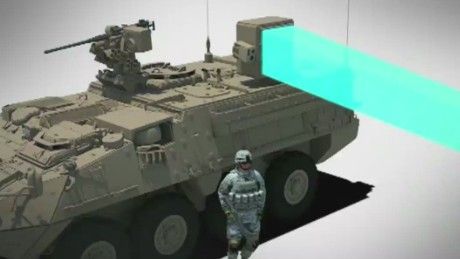The U.S. military is developing a real-life heat ray. CNN’s Thom Patterson explains this non-lethal “active denial system.”

The U.S. military is developing a real-life heat ray. CNN’s Thom Patterson explains this non-lethal “active denial system.”
By Julie Steenhuysen.
(Reuters) — Scientists behind the discovery of a technology called CRISPR-Cas9 that allows researchers to edit virtually any gene they target are among the top contenders for Nobel prizes next month, according to an annual analysis by Thomson Reuters.
The predictions announced on Thursday come from the Intellectual Property & Science unit of Thomson Reuters (which also owns the Reuters news service). Since 2002, it has accurately identified 37 scientists who went on to become Nobel laureates, although not necessarily in the year in which they were named.
Don’t get overly excited about computers and artificial intelligence replacing humans , at least not yet says Andrew Ng, chief scientist at the Chinese search giant Biadu. Computers are still in the “supervised learning” stage where human input is required to connect dots.
“Major financial institutions like some technical features of Bitcoin but are building their own versions that leave out the digital cash and built-in economics.”
Tags: banks, blockchain
[From Engadget]…
While NASA has already shown us Pluto’s best images yet, the administration is anything but done blowing our minds. What you see above is an enhanced high-resolution color view of Pluto, created with a combination of blue, red and infrared images. NASA says this photo, taken by New Horizons spacecraft, highlights Pluto’s diverse landforms and shows us its complex geological and climatological story — as much as scientists have been able to figure out, anyway. Over the past few months, NASA’s shared many things related to Pluto, including a closer look at its desolate surface and icy mountain range.
Tags: New Horizons, Pluto, Solar system, space
By Steve Gorman LOS ANGELES (Reuters) — A brain-to-computer technology that can translate thoughts into leg movements has enabled a man paralyzed from the waist down by a spinal cord injury to become the first such patient to walk without the use of robotics, doctors in Southern California reported on Wednesday. The slow, halting first steps of the 28-year-old paraplegic were documented in a preliminary study published in the British-based Journal of NeuroEngineering and Rehabilitation, along with a YouTube video. The feat was accomplished using a system allowing the brain to bypass the injured spinal cord and instead send messages through a computer algorithm to electrodes placed around the patient’s knees to trigger controlled leg muscle movements.
Two black holes, circling one another on their way to merging together, can create ripples in spacetime, but the waves are weaker than previously thought.
The dark, fingerlike features that creep down steep Martian slopes in warm weather continue to puzzle scientists.
These “recurring slope lineae” (RSL), which have been spotted by NASA’s Mars Reconnaissance Orbiter (MRO) at low and middle latitudes on the Red Planet, fade during cooler months but come back again annually at nearly the same locations over multiple Martian years.
Scientists continue to debate the true nature of the RSL phenomenon; no guess as to what they are and why they occur yet satisfies all observations. And just how RSL sites should be explored generates spirited debate, as evidenced by the discussions that emerged during the second Mars 2020 Landing Site Workshop, which was held last month in Monrovia, California. [Photos: The Search for Water on Mars].

Aristotle is frequently regarded as one of the greatest thinkers of antiquity. So why didn’t he think much of his brain?
In this brief history of the brain, the GPA explores what the great minds of the past thought about thought. And we discover that questions that seem to have obvious answers today were anything but self-evident for the individuals that first tackled them. And that conversely, sometimes the facts which we simply accept to be true can be blinding, preventing us from making deeper discoveries about our our world and ourselves.
Tags: aristotle, Brain, debate, hippocrates, history, mind, Neurology, neuron, philosophers, philosophy of mind, scientists
